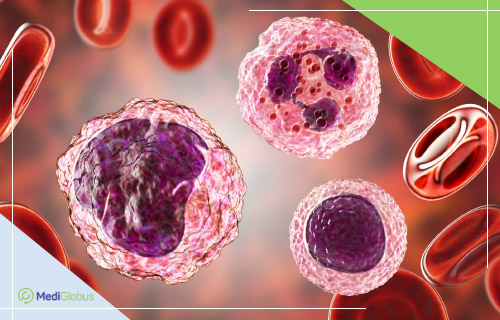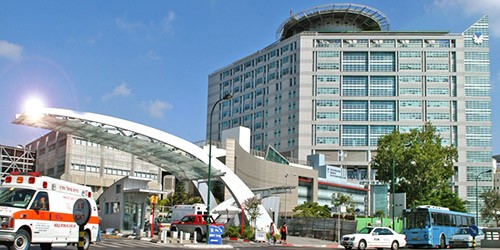MALT lymphoma is a rare, slow-growing cancer with a good prognosis of treatment. It belongs to the group of non-Hodgkin’s lymphomas and on average accounts for 7% of all cases. MALT lymphoma is predominantly diagnosed in men over 60 years of age, but in recent years the incidence has begun to increase in the 40+ category.
There is a reasonably good chance of detecting MALT lymphoma in the early stages, when it is successfully treated conservatively. However, even in the later stages, patients can be helped using a wider range of cancer therapies. Read our article to learn about these advanced treatments and the prognosis of MALT lymphoma of the stomach, lungs and other organs.
What is MALT lymphoma?

MALT lymphoma (MALT – mucosa-associated lymphoid tissue) is a type of non-Hodgkin’s lymphoma that develops not from lymph nodes but from B-lymphocytes in the mucosal tissue of internal organs. The disease produces slow-growing tumours that can spread throughout the body, but they are often detected early when treatment is most effective. An essential factor in this achievement is undergoing regular check-ups, which is particularly important for people who are older and have a predisposition to developing certain diseases.
One-third of all patients are diagnosed with MALT lymphoma of the stomach, but in addition to this, the disease can also affect the lungs, eyes, mucous glands and intestines. The treatment regimen for each organ will differ, but in general, doctors divide the disease into gastric and non-gastric MALT lymphoma.
The main risk factors for developing MALT lymphoma are certain bacterial, viral, and immune diseases:
MALT lymphoma of the stomach is mostly associated with the bacterium Helicobacter pylori – the same one that provokes peptic ulcer – and its treatment strategy is closely related to controlling the infection.
Hepatitis C is among the risk factors for the development of MALT lymphoma.
Other bacterial strains such as Achromobacter xylosoxidans, Campylobacter jejuni, Borrelia burgdorferi, C. psittiaci are capable of provoking the development of this cancer – usually in organs other than the stomach.
The diagnosis is also associated with conditions such as Hashimoto’s disease and Sjögren’s syndrome.
In approximately 2% of patients, MALT lymphoma may progress to aggressive B large cell lymphoma. The prognosis for treatment of such disease will be less favourable.
Symptoms of MALT lymphoma
MALT lymphoma is often asymptomatic in its early stages. Therefore, for its timely detection, regular examinations by specialised doctors and check-ups are important.
The symptomatology of the disease depends on which organ was affected first:
Symptoms of MALT lymphoma of the stomach:
Heartburn and indigestion;
Abdominal pain;
Nausea and vomiting;
Loss of appetite;
Unexplained weight loss;
Gastrointestinal bleeding..
Symptoms of MALT lymphoma of the lungs:
Shortness of breath;
Chest pain;
Coughing, sometimes with blood.
MALT lymphoma of the salivary glands causes them to swell.
Symptoms of MALT lymphoma of the eyes:
Swelling around the eyes;
Sagging eyelids – most often on one side only;
Irritated or reddened eyes;
Double vision.
Diagnosis of the disease
For an accurate diagnosis, doctors prescribe a set of examination procedures and analyses.
In the presence of gastroenterological symptoms, the most indicative diagnostic method is upper endoscopy – examination of the stomach using a thin flexible tube with a video camera. The set of mandatory investigations also includes an H.pylori test and blood tests – CBC, LDH, CMP and a hepatitis C test.
Depending on the individual situation, a biopsy – taking a tissue sample with a needle for further laboratory examination for cancer cells – may be performed.
Often, the doctor may also perform imaging diagnostics – specifically CT and PET scans. These tests highlight a cluster of cancer cells on an image and will be particularly useful in diagnosing MALT lung lymphoma or any form of the disease in its advanced stages.

MALT lymphoma of the stomach – prognosis and treatment
MALT lymphoma of the stomach is the most common form of the disease. In most patients, the disease is associated with chronic infection with the bacterium perform, and the treatment regimen for this disease is closely related to its control. After doctors discovered the link between the two diseases, patient survival rates increased rapidly. A study by Japanese specialists at Kyushu University showed a 10-year survival rate of 86-95%.
The treatment plan for MALT gastric lymphoma depends on the stage of the disease:
| Stage of the disease | Stage description | Treatment strategy |
|---|---|---|
| Stage 1 | Localised tumour | The main method of treatment in the first stages is the elimination of the infection followed by radiotherapy. If the disease is detected at the beginning, treatment of the bacterial infection may be completely limited. If the patient is H.pylori-negative, a combination of chemoradiation therapy and surgery is used for treatment. The latter option is increasingly rare in modern cancer centres, and doctors prefer to avoid unnecessary surgery. |
| Stage 2 | The cancerous process has spread to lymph nodes or neighbouring tissues and organs. | In the second stage of MALT lymphoma of the stomach, radiation therapy and chemotherapy remain the main methods of treatment. Treatment of H.pylori infection remains relevant. |
| Stage 4 | Cancer cells have been detected in distant lymph nodes and bone marrow. | In stage 4 MALT lymphoma of the stomach, the main treatments are chemotherapy and treatment of H.pylori infection. |
Immunotherapy with monoclonal antibodies can also be used in all stages of MALT lymphoma.
More about the specifics of each method:
Antibiotics, which are used to treat H.pylori, are effective in treating MALT gastric lymphoma in 70-80% of patients.
Radiation therapy with gentle doses of radiation can achieve remission in 93-100% of patients. Current protocols recommend using the lowest possible radiation to avoid harmful effects on healthy tissue and reduce side effects.
Chemotherapy is more commonly used in the later stages of the disease, especially in antibiotic-resistant forms of the disease. Doctors may prescribe several different drugs or protocols (combinations of drugs). Given that many patients are elderly, leading cancer centres place great emphasis on controlling side effects and maintaining a good standard of living.
Monoclonal antibodies are a form of immunotherapy, which involves the use of synthetic agents to boost the patient’s immune system and set them up to fight the cancer. They can often be used in combination with radiotherapy or chemotherapy, enhancing their effectiveness, especially in advanced stages and with antibiotic-resistant disease.
Among the factors for a good prognosis of MALT lymphoma treatment are age less than 70 years, stage 1-2 disease, good tolerance to antibiotics and normal LDH levels.
MALT lung lymphoma – prognosis and treatment
MALT lung lymphoma is rare, however, it should not be underestimated. About half of cases are asymptomatic, so timely check-ups and chest fluorography play an important role. Patients with comorbidities such as systemic lupus erythematosus, rheumatoid arthritis, hepatitis C, Sjögren’s syndrome and HIV infection should be especially attentive to their health. Physicians may suspect the presence of the disease on physical examination even in the absence of symptoms.
The disease often shows up ambiguously on diagnostic results, plus it is important to rule out lung cancer, so a biopsy is almost always performed.
MALT lung lymphoma develops slowly, so it responds well to treatment. The disease can recur, so patients often go through periods of improvement and deterioration. However, despite this, the disease is well controlled and patients have an optimistic life prognosis.
There is currently no single treatment protocol for MALT lung lymphoma, so it is important to consult an experienced specialist. Depending on the stage of the disease, the histology and the patient’s condition, doctors use a combination of surgery (thoracoscopic resection), chemotherapy, immunotherapy and radiotherapy.

Treatment of disease relapse
According to various data, MALT lymphoma recurs in 3-21% of patients after successful treatment of the disease. Moreover, the cancer can return even 7 years after achieving remission, while for most cancers the threshold after 5 years is considered a “safe zone”.
MALT lymphoma can return in the same site where the disease was first detected, or in a different organ (e.g., in the right lung instead of the left lung). The prognosis for the treatment of relapse is also considered optimistic. The oncotherapy plan will depend on the location of the tumour and past treatments.
The methods used to treat relapsed MALT lymphoma usually consist of chemotherapy combined with targeted therapy or radiation therapy. In the most severe cases, if the disease has returned soon after successful treatment, the patient may need a bone marrow transplant. Autologous bone marrow transplantation (using the patient’s stem cells) is used for this diagnosis, so finding a suitable donor should not be a worry. Stem cell transplantation is a very intensive form of treatment and the patient must be healthy enough to undergo it. Before the transplant itself, treatment with very high doses of chemotherapy must be tolerated.
Clinics for the treatment of MALT lymphoma
Summary
MALT lymphoma is a slow-growing malignant form of cancer that most commonly forms in the stomach, lungs, salivary glands, and other organs. The disease most often affects men over 60+ years of age, is associated with bacterial/viral infections and immune diseases, and has a good treatment prognosis.
To treat MALT lymphoma of the stomach, lungs, and other organs, antibiotic therapy, chemotherapy, chemotherapy, radiation therapy, chemoradiation therapy, and immunotherapy are used. Surgery is used less frequently but is also a treatment option.
The prognosis of MALT lymphoma treatment is up to 95%, but once remission is achieved, regular cancer check-ups should be performed as the disease may return. Relapse is also successfully treated with modern methods.
For MALT lymphoma treatment abroad, the international platform MediGlobus recommends applying to Liv, Koç (Turkey), Navarra (Spain), Ichilov (Israel), Fuda (China) and SoonChunHyang (South Korea).
Sources:
- 1. Cancer Research UK
- 2. Lymphoma Action
- 3. Journal of Medicine and Life
- 4. Cancers (Basel)
- 5. American Journal of Translational Research
- 6. Gut












